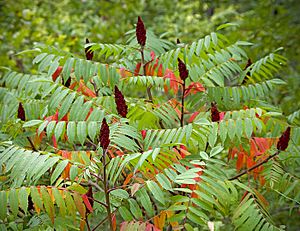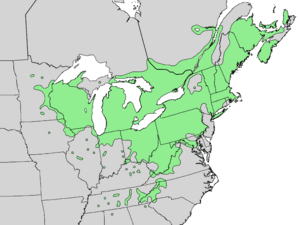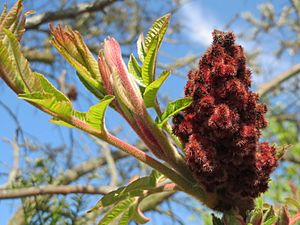Staghorn sumac facts for kids
Quick facts for kids Staghorn sumac |
|
|---|---|
 |
|
| Conservation status | |
| Scientific classification | |
| Genus: |
Rhus
|
| Species: |
typhina
|
 |
|
| Synonyms | |
|
Rhus hirta |
|
The staghorn sumac (scientific name: Rhus typhina) is a cool flowering plant. It belongs to the Anacardiaceae family. This plant is originally from eastern North America, including parts of Canada and the United States. People grow it in gardens around the world because it looks nice. However, in some places, it can spread very quickly and become an invasive plant.
Contents
What's in a Name?
The name "staghorn sumac" comes from how its branches look. The Latin part of its scientific name, typhina, means "rough like antlers in velvet." This is because the branches are covered in soft, fuzzy hairs, much like a deer's antlers when they are growing.
About the Staghorn Sumac Plant
Staghorn sumac is a deciduous shrub or small tree. This means it loses its leaves in the fall. It can grow up to 5 meters (about 16 feet) tall and spread out about 6 meters (about 20 feet) wide.
Its leaves are long, usually 25 to 55 centimeters (10 to 22 inches). Each leaf has many smaller leaflets, from 9 to 31 of them. These leaflets are about 6 to 11 centimeters (2.5 to 4.5 inches) long. The stems and leaf stalks are covered in reddish-brown hairs, which makes them feel velvety. This fuzzy texture and the way the branches fork out, like deer antlers, gave the plant its common name.
Staghorn sumac plants are either male or female. This is called being dioecious.
Flowers and Fruit
Small flowers grow on the plant from May to July. They are usually greenish-white or yellowish. These flowers grow in tight bunches at the ends of the branches.
After the flowers, small, round fruits appear. These fruits are called drupes and are green, turning reddish as they ripen. They grow in dense clusters that are about 10 to 20 centimeters (4 to 8 inches) long. The fruit ripens from June to September. These fruit clusters can stay on the plant from late summer all the way through spring. Many birds eat them during the winter.
How it Spreads
Staghorn sumac spreads in two main ways: by seeds and by underground stems called rhizomes. Because of its rhizomes, it often forms large groups of plants that are all connected. The older plants are usually in the middle, with younger shoots growing around them.
It's important to know that staghorn sumac is not related to poison sumac (Toxicodendron vernix), even though they share the name "sumac." Poison sumac can cause skin rashes, but staghorn sumac does not.
Sometimes, in late summer, you might see small bumps called galls on the underside of the leaves. These are caused by tiny insects called sumac leaf gall aphids. These galls usually don't hurt the tree much.
Growing Staghorn Sumac
Staghorn sumac is a popular plant for gardens because it looks interesting all year round. However, it spreads very quickly by sending out new shoots from its roots. This means it might not be the best choice for small gardens.
This plant can grow in many different conditions. It often does well in dry, poor soil where other plants might struggle. Some gardeners trim the plant to remove all but the top branches. This makes it look like a small palm tree.
Many special types of staghorn sumac have been created for gardens. Two of these have won an award called the Royal Horticultural Society’s Award of Garden Merit:
- Rhus typhina 'Dissecta' (This one has finely cut leaves.)
- Rhus typhina Radiance = 'Sinrus'
Uses of Staghorn Sumac
The fruits of sumac plants are safe to eat. You can soak them in cold water, strain the liquid, and then sweeten it to make a pink drink. This drink is sometimes called "Indian lemonade." You can also use this drink to make jelly. The young shoots of the plant can be peeled and eaten raw. Studies have shown that the fruit has natural properties that can help fight off harmful things like bacteria.
Almost all parts of the staghorn sumac plant, except for the roots, can be used to make natural dyes. They can also be used as a mordant, which is something that helps other dyes stick to fabric better. The plant has a lot of tannins, which are natural chemicals that help improve how well colors last when dyed. You can collect the leaves in the summer and the bark at any time of the year.
See also
 In Spanish: Zumaque de Virginia para niños
In Spanish: Zumaque de Virginia para niños




